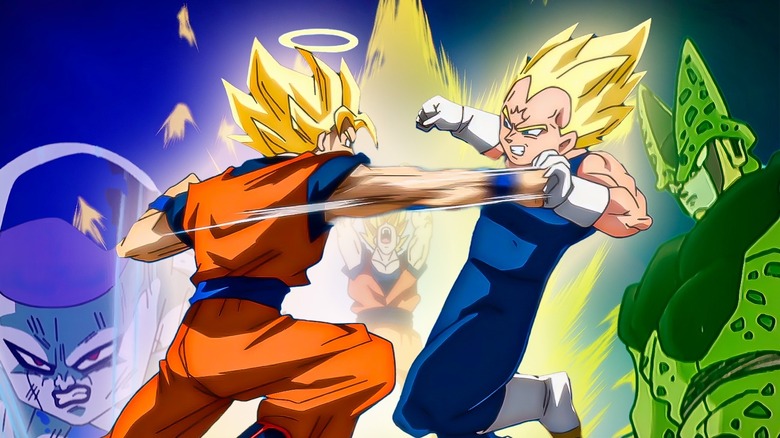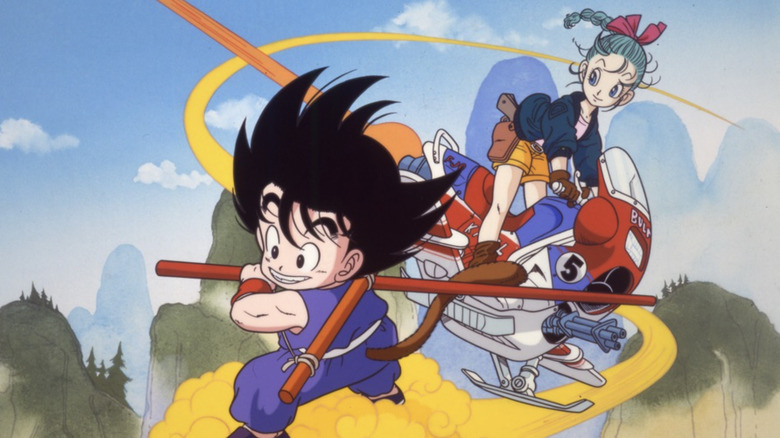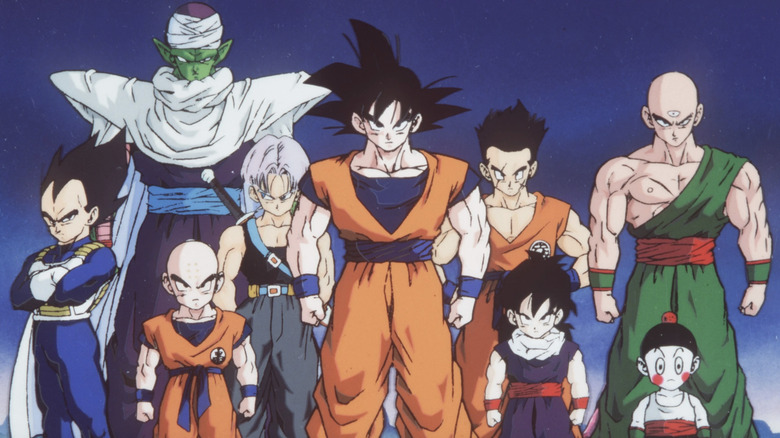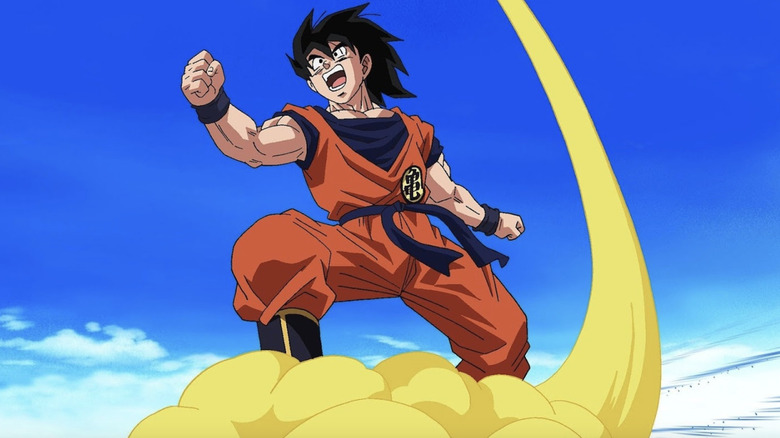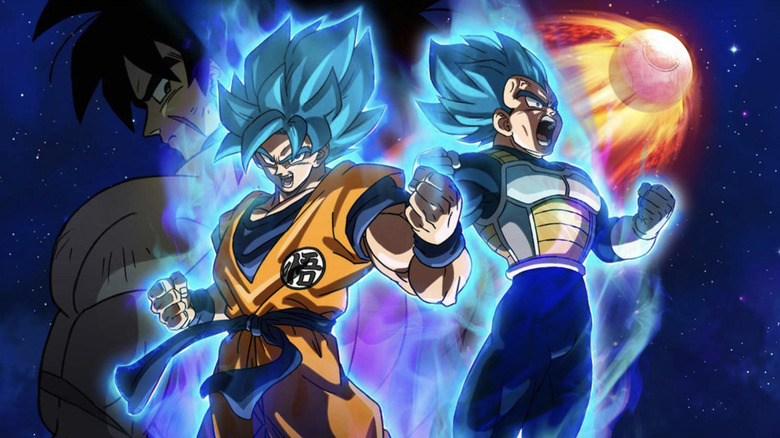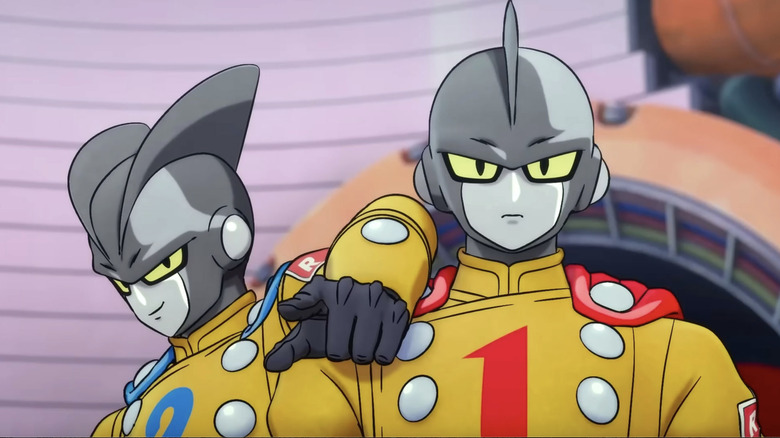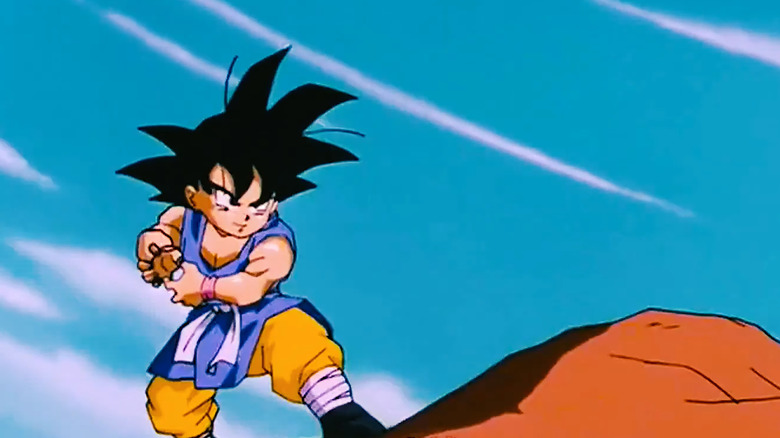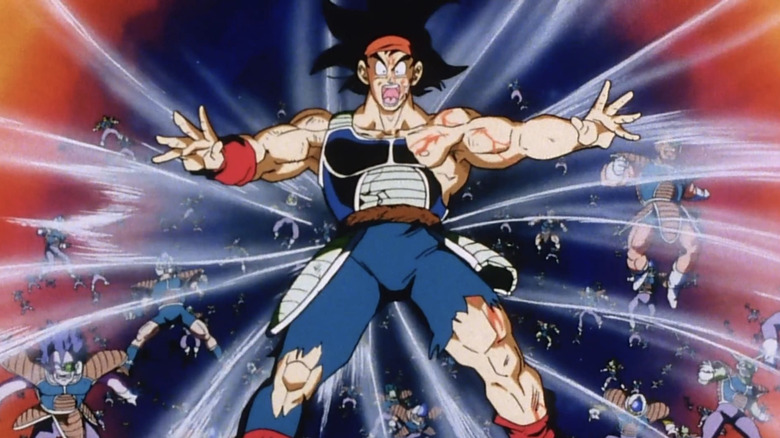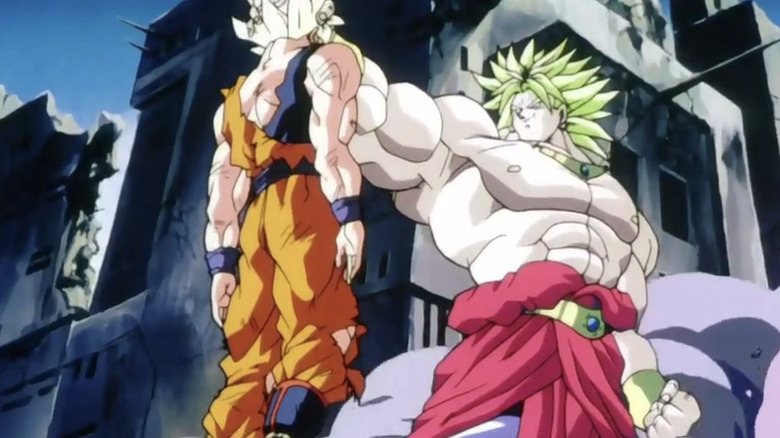A Dragon Ball Beginner's Guide: Where To Start Watching The Classic Anime
Whether you're a fan of anime or not, you've most likely heard of "Dragon Ball." The iconic series, created by Akira Toriyama, has helped define modern-day Shonen anime with creatively designed characters, worlds, and stories. The anime grew past its original conception as an action-comedy, eventually spanning two sequel series, with "Dragon Ball Z" becoming the most well-known of the many series made thus far. Consisting of five different shows with a total of 806 episodes and 20 movies, getting into this famous series can feel overwhelming. After all, there are multiple avenues to take to experience the story of Goku and the rest of the Z fighters.
"Dragon Ball," tells the story of Son Goku, a young warrior who goes on a journey to become a strong and capable fighter. With otherworldly strength and a peculiar monkey tail, Goku makes all sorts of acquaintances and enemies (who later become friends). Along the way, Goku learns about the mythical Dragon Balls and how once they are all gathered, someone can use them to summon Shenron, a creature that can grant one wish. "Dragon Ball," which aired from 1986-1989, covers Goku's childhood and training. "Dragon Ball Z" picks up five years after the end of the first series and aired from 1989-96. Following the ending of that series, the non-canonical "Dragon Ball GT" would air from 1996-97, and the franchise would triumphantly return in 2015 with the canonical "Dragon Ball Super," airing its most recent episode in 2018.
To help decide how you want to view the classic anime, we at /Film have created this guide to help newcomers to the franchise better understand their options.
The competionist journey: Dragon Ball
Some Shonen fans may skip the "Dragon Ball" series entirely because, while it has its fair share of action, the original series is much more of a comedy. This first installment has a different sense of adventure than "Dragon Ball Z." Almost everything in "Dragon Ball" is played for jokes until Piccolo shows up later in the story. However, the series is still the starting point of Goku's journey. If you're looking for the complete experience, dip your toes in a different adventure serial type of anime. For those who have only known about "Dragon Ball Z," it could be a refreshing departure that is a more lighthearted watch than its sequel series.
"Dragon Ball" consists of 153 episodes and has the foes Goku goes up against while retrieving Dragon Balls or going through training feeling like shadows of the major villains that take the stage in the next series. If you're looking for some of the highlights of this original "Dragon Ball," look no further than the "Tournament Saga" (episodes 14-28), the "King Piccolo Saga" (episodes 102-122), and the "Piccolo Jr. Saga" (episode 123- 153). Each of these highlight what people love about "Dragon Ball"— incredible action and fights fueled by rivalries that later become friendships, along with planting the seeds for the next chapter of the story in "Dragon Ball Z." This is the perfect starting point for fans who want the complete experience.
Follow it up with: "Dragon Ball Z," then "Dragon Ball Super."
The Shonen everyone talks about: Dragon Ball Z
The end of "Dragon Ball" has Goku as an adult, married to Chi-Chi, and feels like a proper bookend for the start of the story. The next chapter, "Dragon Ball Z," is arguably the most well-known. "Dragon Ball Z" changed the perception of Japanese animation in Western pop culture, normalizing the appreciation of what was formerly a niche genre of television. The first arc of the series exemplifies everything great about it, as the Saiyan Saga (episodes 1-35) provides insight into Goku's origins and flips the world's status quo on its head. Add to that the introduction of characters like Goku's son Gohan or the prince of Saiyans Vegeta, who starts as a villain at the beginning of the series, and it's easy to start this next step in your "Dragon Ball" journey and never look back.
Goku isn't the only character who takes the spotlight, either. "Dragon Ball Z" is much more of a generational story, showing Gohan coming into his own as a person and a fighter while humanizing Piccolo, a primary antagonist from the previous series. Stick with the series long enough, and you can bear witness to one of the most iconic moments in all of anime — Goku becoming Super Saiyan in the "Frieza Saga" (episodes 75-107). It's a chill-inducing arc that sets the precedent for many more transformations down the line. If you decide to skip "Dragon Ball" and go straight into "Z," it shouldn't be a problem. However, cutting around arcs in this 291-episode series may end up lessening the dramatic effect some of these emotionally cathartic episodes entail. Purists may want to watch this original series in all its unedited glory.
Follow it up with: "Dragon Ball Super."
The filler-free Shonen experience: Dragon Ball Z Kai
If the comedic origins of "Dragon Ball" don't interest you and you're wanting to get straight into the classic Shonen everyone talks about without the filler, "Dragon Ball Z Kai" is the perfect starting point. Clocking in at 167 episodes (compared to the original "Z's" 291 episodes), there's significantly less filler in this re-animated version of the original "Dragon Ball Z" anime. Featuring re-recorded voice tracks and new HD animation, it's a perfectly suitable abridged version of the "Dragon Ball Z" story. The original version of this story was made just as chapters of the manga were being released, forcing the studio to slow down the pace and add in their own filler so that they wouldn't get too ahead of the manga. Thankfully, "Dragon Ball Z Kai" had none of those restraints, and with the manga complete, was able to tell the story as concisely as possible.
Anime filler has been the bane of many people's viewings of other big anime like "Bleach" or "One Piece," so the rarity of having an updated version of the story may make "Dragon Ball Z Kai" the best way to experience the story. At the end of the day, it's all a matter of preference, and "Dragon Ball" gives you two different ways to experience the most popular of its three series. Whether it's "Dragon Ball Z" or "Dragon Ball Z Kai," all roads lead to the newest series.
Follow it up with: "Dragon Ball Super."
The latest and greatest: Dragon Ball Super
The latest (and shortest) "Dragon Ball" series, "Dragon Ball Super" increases the story's scale and provides exciting power-ups for its cast of characters. Introducing new lore with "Gods of Destruction" and the idea of a multiverse filled with alternate reality Saiyans and Gods, "Super" is as big as "Dragon Ball" gets. The anime requires little to no knowledge of the previous events but comes at the cost of having little shock value for callback moments, like the "Resurrection F" storyline.
"Dragon Ball Super" is mostly a separate series that fans watch for new storylines. like the "Universe Survival Arc" (episodes 77-131), which sees Goku, Vegeta, and the other Z-Fighters participate in a tournament that decides which universes survive and which don't. It's the biggest tournament the series has ever done, filled with incredible moments that lead to an explosive and emotionally charged three-way fight that needs to be seen to be believed. "Dragon Ball Super" has not aired any new episodes since 2018, though the manga of the same name is still ongoing. Despite the lack of official announcements, the recent release of a "Dragon Ball Super: Super Hero" movie seems to indicate there more than likely will be future episodes in the series. For now, though, it's ended at 131 episodes.
Here are all the different ways to experience the story of "Dragon Ball." It's important to note that one of these routes cuts out the original "Dragon Ball" entirely, and goes straight into Shonen territory if you're looking for an abridged story:
- "Dragon Ball" to "Dragon Ball Z," to "Dragon Ball Super": 571 episodes.
- "Dragon Ball" to Dragon Ball Z Kai" to "Dragon Ball Super": 451 episodes.
- "Dragon Ball Z Kai" to "Dragon Ball Super": 298 episodes.
Canon movies that continue the story of Dragon Ball Super
If by now you've watched all the series you've wanted and think you've completed your "Dragon Ball" journey, think again. While "Dragon Ball Super" hasn't aired a new episode since 2018, two films have been released that are canon to the "Dragon Ball Super" anime and continue the story in new and exciting ways. Both movies released so far have stories written by creator Akira Toriyama and are the final step in watching the entire story of the anime.
- "Dragon Ball Super: Broly": Released in 2019, "Broly" made a fan-favorite "Dragon Ball Z" film character named Broly canon and picks up right where "Super" ended. Filled with incredible animation that mixes 2D and CG, "Broly" is a natural continuation of the series and adds a new set of characters to join the Z fighters in future endeavors.
- "Dragon Ball Super: Super Hero": Released in 2022, "Super Hero" is essential because of how it gives Gohan and Piccolo, two characters who were prominent in "Dragon Ball Z" and sidelined in "Super," much-needed power-ups and new transformations. The animation style is a departure from anything the series has done before and sets the stage for when "Super" inevitably returns for new episodes.
The non-canon experience: Dragon Ball GT
If you want to go all in on the "Dragon Ball" experience and are itching for more after watching everything else listed in this guide so far, I just want to say; my hats off to you. Also, "Dragon Ball GT" might be worth checking out if you want to fill your time with more stories of Son Goku and his adventures. "GT" sees Goku being turned back into a kid due to a misguided animation studio believing that the best way forward is backward, regressing their main character to a state similar to the original "Dragon Ball" anime. While the "Dragon Ball" community may look down upon this attempt at a sequel, there are still some positive traits to it, such as the unique design of Super Saiyan 4 and the inclusion of characters like Uub.
"Dragon Ball GT" consists of 64 episodes spread across two seasons, and the series that followed it, "Dragon Ball Super," is not connected to it in any way, shape, or form. This anime series is an odd mark in the history of "Dragon Ball" projects. While there have been plenty of films that aren't canon to the universe of the Z fighters, this is the first and only series with no bearing on the greater world or characters. However, it's interesting enough to warrant a place on this guide if you've already taken in all the canon stories and want to see a "Dragon Ball" story that had little involvement from its original creator, Akira Toriyama.
Non-canon movies that explore Dragon Ball lore
Another entry in the supplemental viewing category is a list of "Dragon Ball Z" movies that, while not canon, fully explore story points mentioned only in passing in the anime. Each of these films complements different arcs in the anime and gives fans of the series a better understanding of the world and characters.
- "Dragon Ball Z: Bardock – The Father of Goku": Per the self-explanatory title, this film explores the life of Goku's father and his eventual failed uprising against Frieza before the alien warlord destroys Planet Vegeta, the home of the Saiyans. In this pseudo-Superman origin, Bardock is cursed with visions of the future and his planet's destruction as he desperately tries to warn others of impending doom. The film serves as an emotional prologue to the rest of the series, even if it's not canon.
- "Dragon Ball Z: The History of Trunks": This alternate timeline film is a perfect companion to the Cell Saga of "Dragon Ball Z," and it could technically take place between episodes 175 and 176 of that series. A much darker tale than what's usually expected of "Dragon Ball," the focus on Gohan as a mentor figure to Trunks paired with the post-apocalyptic "Terminator" vibe makes "The History of Trunks" an incredible change of pace in a truly heartfelt story.
Dragon Ball movies if you're looking for fan-favorite characters
In the long history of "Dragon Ball Z" movies, there are characters and stories that stand the test of time and are considered classics. Here is a list of films you can watch that feature some genuinely incredible "Dragon Ball" villains that don't make an appearance in the anime:
- "Dragon Ball Z: Fusion Reborn": An all-out brawl featuring almost every "Dragon Ball" character, it's famous thanks to its unexpected matchups and use of Super Saiyan 3. The movie lives up to its "fusion" subtitle, with fan-favorite characters like Goku and Vegeta fusing together to become one mighty fighter. Filled with fan service and mind-blowing moments, this is a very entertaining watch.
- "Dragon Ball Z: Broly – The Legendary Super Saiyan": The debut of Broly, a sadistic and physically imposing villain, this film boasts some of the most vicious fights in any of the films. The introduction of Broly works as a segue to explore the history of the Saiyans before their destruction, featuring a perfect balance of emotional storytelling and mindless fight scenes that pack an extra punch.
- "Dragon Ball Z: Cooler's Revenge": Cooler is a popular character in "Dragon Ball" lore. As the brother of Frieza, Cooler decides to take revenge on the Z fighters for their role in his death. In a rarity for "Dragon Ball" films, Goku takes more of a backseat as characters like Piccolo and Gohan step up for some of the more critical fights in the movie.
There's a reason why "Dragon Ball" is one of the greatest Shonen ever made. Its success inspired many other creators, and based on the number of movies and series to choose from, Akira Toriyama's manga is filled with incredible characters and expansive stories that seemingly have no end. Hopefully, this beginner's guide will help you find the way you want to approach this anime. There's not really a wrong way, as long as you're having a good time.
